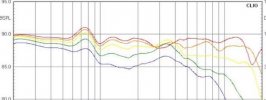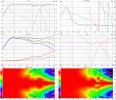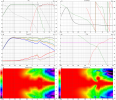Is there any truth to his claims about good capacitors being "faster" than bad ones? Assuming two different capacitors have the same exact value, do they function identically? (For the sake of this hypothetical, let's ignore any capacitance margin of error which might be more common for cheaper capacitors and assume both ACTUALLY DO have the exact same value, and let's also not get into longevity of electrolytic media, let's just focus on the signal output).
Application, application, and application.
Within a crossover network not all the capacitors share the same job so to say.
For example in the low pass filter woofer circuit the capacitor is in parallel with the load, any current/signal it passes does not pass through the woofer, it's just a path back to the source. It's there to give the filter a steeper slope. These typically require largish values like >80uF, since it doesn't effect sound quality engineers appreciate the small footprint and low cost of an electrolytic. One thing I noticed when changing from electrolytic to film here was a resonance popped up. At around 350Hz the signal was
higher than the input, this is due to the resonance, so signals at around this frequency are boosted which isn't good. The 2 ohms or so of ESR in the electrolytic damped the resonance and flattened the response, so keep this in mind when you swap from lytic to film here, measure to see if there is any bump in frequency response which could account for people hearing a difference between the two and making the wrong assumption. One may need to add a small value resistor in series with a film cap here or possibly a zobel network to dampen the resonance. Why not just use the cheap capacitor that does everything you want all in one package? Makes sense to me. The series inductor here carries both the shunt currents through the capacitor and also the currents through the driver. It's of importance the DCR of the inductor is low and that if iron core it's large enough to not saturate. He likes to use air core inductors and here it would need to be huge to get enough inductance and low enough DCR. To me it's more efficient to use a high quality core inductor sized appropriately to not saturate. Danny even says himself that distortion at low frequencies aren't really that audible compared to mid frequency distortion so he truly believes that it's more important to put high quality inductors in the high pass filters, which is pointless as I will explain in the next paragraph. So the most crucial inductor in the entire network is the one in the woofer circuit. Erse high Q inductors work great and I haven't seen one saturate in my networks, DCR is lower compared to air cores I looked at which is better for low losses and better damping control.
For high pass filters, in a two way design this would be for the tweeter circuit, and for a three way the mid driver and tweeter. The capacitors are in series with the drivers, this means that both the currents through the drivers and if the speaker has higher order (steeper) filters the shunt inductor that shunts the signal away from the driver and back to the source both these currents sum and the total current passes through the capacitor. We can view these series capacitors as having 3 main operating areas where it's behavior and impact on signal changes. First is above the crossover frequency, these are the frequencies we want to pass through to the drivers, the capacitor is of low impedance here and the shunt inductor is of high impedance allowing the majority of signal to reach the driver. The impedance of the capacitor is very low here and the capacitor is basically not impeding the signal, here is where equivalent series resistance might come into play if it's higher than the reactance of said capacitor. This creates some loss into the capacitor, electrolytics have higher ESR, due to it's higher internal loss angle. So we want a capacitor with a low ESR. Second is at the crossover frequency, as it's impedance is now starting to increase and you will begin to get a larger voltage drop across it's terminals, phase shift also begins here. We are beginning to want to dump these frequencies and anything lower away from the driver. The impedance of the shunt inductor is beginning to drop here also shunting more signal away from the driver. Finally below crossover frequency, we don't want these frequencies getting to the driver, the series capacitor of high impedance and the shunt inductor is of low impedance, they create a divider network keeping these unwanted frequencies from passing through the drivers. If the signal is just being dumped away from the driver then who cares about the quality of the inductors here? They don't play a significant role other than a low impedance path back to the source. To summarize the most important frequencies are the ones going to the driver and here the capacitors are of very low reactance/impedance, ESR will dominate in this region so film caps are better in this regard as they have the lowest ESR or loss angle.
Now "speed" of a capacitor. This is something Danny made up and isn't really a property of capacitors. Higher frequencies alternate current direction faster, and so impedance naturally drops as frequency increases given the same capacitance value, to the point where ESR begins to dominate, this is possibly what he means by "faster" where faster changing signals will be less impeded due to the lower ESR. But I have a feeling this is not what he means because it's not what he describes, he describes the speaker or signal to be faster which is ridiculous. I think he is confusing something like Slew rate into his argument which is a large signal phenomena. As the amplitude increases along with frequency, to drive capacitance you need more current in order for the signal not to distort. Slew rate is often the only variable related to speed. The capacitor itself cannot change this, it's to do with the source and how much current it can deliver to charge the capacitance with high amplitude high frequency signals. The other possibility to do with speed is time constants but this doesn't have anything to do with the type of capacitor either, it's more to do with series resistance and capacitance acting together making the time to charge up faster/slower. The more resistance given the same capacitance value the longer it takes to become fully charged. Current delivery is defined by; I = C * (dV/dT) so again this tells us that given a particular change in voltage over a given change in time, multiplied by the capacitance value equals current. I think that just about covers the "speed" issue, it's a made up term by Danny to sell his stuff as he has no idea what real terms mean in electrical engineering. If he did know what he was talking about he wouldn't use such a generic term, he would use a more precise term to explain the exact function to which he is referring, then show or explain the real difference. For example he could install an electrolytic series capacitor with the tweeter and at say 10kHz measure the output to driver to determine the loss in the higher ESR electrolytic compared to a lower ESR capacitor. I've done this many times and often the losses are well below 1% and not very audible if you ask me, but at least it's measurable and one can show proof of a change.
It al boils down to fashion and status. When an "audiophile" pays big money for a status speaker and finds out the passives inside don't share the desired pedigree of "fanciness" they expect in high end things they feel they need to swap out perfectly fine components for more expensive ones just to satisfy their belief that they are special and require special parts. How dare they share the same mundane parts with the "poors", they want to be able to brag about how fancy their passive parts are. I'm fine with this if that's how it's advertised but it's not, Danny advertises a lot more than just a status upgrade. This is where perception and bias kick in, because one knows that the parts inside now fit their life mantra of "only the best" then they now hear their speakers through this mental bias filter and perceive it as better but it's 100% in their minds and not based in reality.
If you are into wine there have been numerous studies where they pour budget wine that is actually quite decent into a much more expensive brands bottle. The taste tests always show that when they are given the same wine in fancy bottle all the silly adjectives start to come out, they notice the hints of fruit, the nose is significantly better etc... But when given the same wine in it's original bottle they review changes course into the negative region only because of cognitive bias. It's silly but true, all of us do this and part of being human but once you are aware of this sort of psychology we can then improve upon better blind testing to remove the cognitive bias function as best as possible. This is why we feel all the good reviews of Danny's products are anecdotal at best and his own hearing tests are moot, well of course he wants to sell you something but it's the reviews that are the real problem. Real people thinking they hear a difference just perpetuates this nonsense and nothing ever changes. I just hope people that spend the money on this stuff do so responsibly; i.e. they can easily afford it. But if someone has been bitten by the audiophool bug and has young children to support and it's the choice of putting money away for their kids or spending it on stupid snake oil parts is when it begins to be a problem. That money could and should be spent towards better things for the family instead of keeping these con artists in business.





